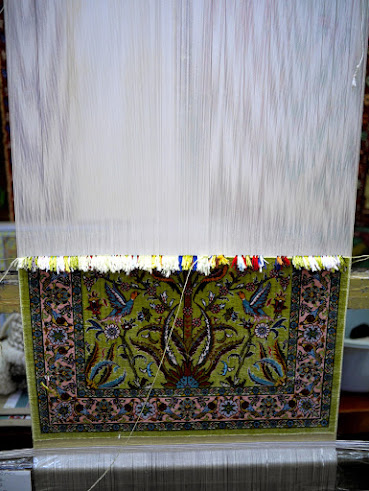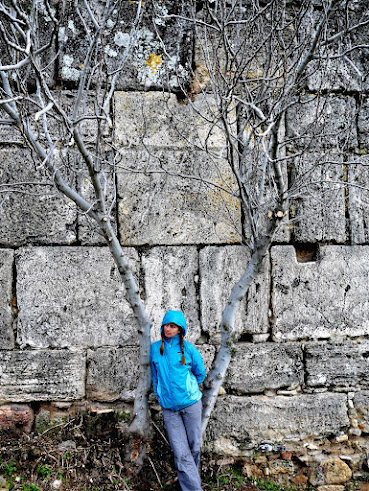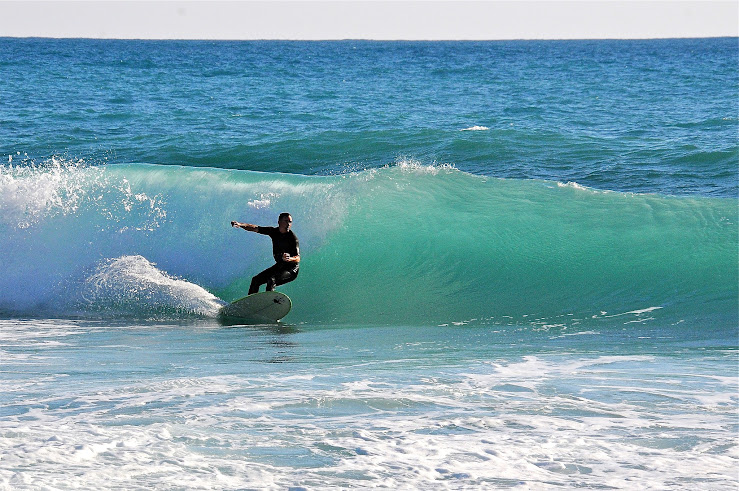As we sped across the narrow channel separating the Greek Island of Chios from Turkey, I thought surf hunting was finished for a while, but I was getting used to being wrong.
The Mediterranean coast of Turkey reminds me of the Big Sur Coast of Northern California with limestone cliffs shooting up dramatically from the blue waters below.
We‘ve become horrendously lazy tourists. Our first stop in Turkey was the ancient city of Ephesos and the only reason we were stopping there was because the guy who owned the pension on Chios had told us about it. This was the place we were about to blow by without a glance.
Hardly worth the trouble, eh?
We just go where someone happens to tell us to. Case in point, when a taxi driver in Ephesos brought us to a carpet shop. Smart idea, right? Let your taxi driver bring you to his friend’s carpet shop instead of where you want to go. We readied ourselves to endure an hour-long hard sell of $3000 Turkish Carpet.

Fortunately, the folks there were incredibly nice – the owner showed us around the place and how the carpets were made. A woman tended to a hundred fluffy little white balls inside a metal tub with water that seemed to be magically spinning. These were the silkworm cocoons being unwound as a single strand and then combined with other strands to make the silk thread that would eventually be used for the carpets. Each carpet is made by a single woman from start to finish, and sometimes they take years to complete the incredibly intricate process of knotting the carpet into various designs. I’d never seen anything like it.
The next stop on the Turkish moto express was even more rad than Ephesos. It might look like Jamie is walking around bare footed in a glacial pool, but the water she’s standing in is actually quite warm. This is a massive mineral deposit, a travertine, blanketing the surface as minerals, mostly Calcium, precipitate out of the hot spring that flows down the cliffside.
At the top of the cliff, we found the ruins of the Roman city of Heiropolis. With a defensible position atop a cliff and a hot spring flowing right through town, I couldn’t think of a nicer place to make home in 700 BC.
At the center of the plateau, we saw one the most surreal sights of the entire journey – a crystal pool of the mineral-rich water with remnants of the glory days of Heiropolis enshrined at the bottom.
We kept up our eastward trajectory along he Turkish coast, winding over craggy headlands, and up and down stream valleys filled with meandering crustal waters. Some days we battled rainstorms, while others were clear as a bell and begging us to get riding.
At every stop along the way, we could hardly go for a walk, without tripping over ancient cities that mostly had relics from Roman and Byzantine times. There was always a theatre of some sort, and when we got tired of waiting for the show to start we put on our own.
The village of Cirali enchanted us more than anywhere else. With clear streams spilling down the towering white cliffs rich with vegetation, it was about as close to riding into Rivendell as I’ve ever felt.
As beautiful a place as it is, the tiny village of Cirali has not yet succumbed to the trappings of a Mediterranean tourist destination. From Cirali, we walked along the rugged coastline historically occupied by the ancient civilization of Lycia dating back to 1250 BC. Control of Lycia was bandied about, fought for, annexed, and succeeded by various pre-eminent civilizations through the centuries including the Persians, the Athenians, and the Macedonians and finally the Romans and Byzantines.

Throughout all of this, Lycian port cities often prospered through trade and Lycia enjoyed periods of self-rule and semi-autonomy from the big boss of the era. The early government of Lycia was a federation with Republican principles, which ended up influencing the framers of the constitution in the good old USA. In addition to a good example for running a civilization, the Lycians left us another great legacy: one of the greatest long-distance trekking routes in the world. Along the Lycian way, you can walk for 500 kilometers along the turquoise ocean and from time to time hopping over ruins from the Roman and Byzantine eras.
We walked beneath the shadow of Mt. Olympus, which was confusing since I thought Mt. Olympus was in Greece. Later I found out that there are like 20 Mt. Olympus’s scattered around Turkey and Greece and it seemed rather less impressive.
The trail climbed over jutting rocky points and dropped down to cobble-strewn beaches that we had mostly to ourselves.
We rested our tired dogs and Jamie started doing some weird hippi dance on the beach.
We rode high above Cirali to find a fissure in the earth that has been on fire for thousands of years, through countless winter storms. The idea is that this place is the inspiration for the monstrous fire-breathing animal of Greek Mythology, the Chimera, first described by Homer in The Illiad. Wisps of flame whipped at the ledges of stone, through a score of fissures climbing up the slope that became ever more luminous as darkness fell.
After we’d seen our share of wonders from the ancient world I was about ready to ride for the coast to see if there were any waves to ride in Turkey. We didn’t have much swell in Israel, but the waves we’d found in Greece gave me hope that I wouldn’t come up empty-handed surfing in the Mediterranean. We’d been lucky all day riding, with the rain threatening, but never delivering. But as we rode into the coastal town of Alanya, our luck ran out and rain came down in buckets soaking us to the skin. In Africa, getting caught in a rainstorm was no big deal since it was rarely very cold, but we weren’t in Africa any more and we were soon shivering in the wind with nothing to do but keep riding.
As we rode along the coast the next day, I was disheartened by what I saw – only the most meager waves lapping onto the shore. Before arriving to the coast I’d connected with the Alanya Surf Team (check them out on Facebook) who invited me to come for a surf at their beach. Surfers have only been riding waves for the last 5 years on the Mediterranean coast of Turkey and there are still only about 10 regular surfers. These guys are among the first to ride a board on a wave on this stretch of coast.
Mehmet-Ali (not pictured) was the first surfer here along with Mehmet (top photo). They told me that initially the coast guard kept trying to drag them out of the water during such dangerous ocean conditions. They first had major difficulties just getting some boards here from Europe, but now they are slowly growing their local surf scene. The water isn’t very cold here, even in the winter, when the storms bring the swell, I was only wearing a 2mm short arm suit and was plenty warm enough. There is a pounding beachbreak that will give up the odd barrel here and there, innumerable peeling reefbreaks of varying quality, and a rivermouth wave. The different breaks are all in a small area and face different directions around a small point, so it’s often easy to surf where the wind is offshore. So close to Europe, it could be an ideal place for European tourists to come learn to surf rather than braving the frigid waters of the North Atlantic.
I’m always happy to meet a local surf crew, but I honestly wasn’t sure exactly what we were going to ride until a few hours later. Along the same stretch of beach I’d seen on the way into town, the surf had tripled in size in the space of a few hours. It was amazing. I raced over to meet Mehmet and Mehmet Ali at the surf club – a hotel run by Mehmet Ali, with boards and suits piled up on top of tables in the lobby. It felt great to jump in the water and paddle again, but it became immediately clear that I was in shocking condition. It seems that sitting on a motorcycle for months on end does not do wonders for one’s physical fitness. After an hour or so, the sun was on its way down and I looked up to the cliff that we were surfing beneath to realize that there was a huge castle perched on top of it. By then I couldn’t stop smiling. I was surfing in Turkey, under a castle.
The next few days the swell stayed up, and every day the guys were on top of it and sent me a message to come surf. I honestly couldn’t believe how good the waves were, by far the best I’d surfed in the Mediterranean. The waves weren’t the weak-feeling short-fetch windswelly stuff that I’d expected – they had similar punch to plenty of your average beachbreaks in California.
Yours truly having a delightful day in the water.



Mehmet found some trim.

Cagri ducked for cover
After surfing one afternoon, I was surprised to find a full camera crew assembled on the beach. Traveling surfers are still a rarity in Turkey, so much so that Mehmet had alerted the local news station to my visit and they showed up on the beach with cameras blazing. With Mehmet translating for me, I told them about the journey, what I was doing in Turkey, and what I thought about the waves in Alanya. It was all pretty funny and I got my moment of fame that night on Turkish television. Never imagined I’d be able to make such a claim.


Turkey really wasn’t on my radar at all for a place to come surfing, but leaving no stone unturned sometimes brings the spoils. It’s been a blast riding waves with the stoked surfers of Alanya. I got to taste again what I had loved so much about surfing in West Africa: the excitement of a new surf scene and the welcoming nature of surfers pioneering their own territory. Surfing is a great way to connect with people. No matter the cultural divides, love of riding waves binds our global tribe together, and I feel so fortunate to be reminded of that in the most unlikely of places.
good journal mate-nicely written-photos and treasure waves
thnx for sharing
hey thanks much wal – glad you like the tales..
Still love your photos & your storytelling. Can’t wait to hear what happens next. 2N is following your adventures and taking bets on where you end up next.
hey Mags! Glad 2N is still on board. I can’t wait to see what happens next either – we’ve been stalled in Turkey for some time now. Crossing the mountains was coooooold, so we’re a bit scared of the Alps in spring.
Checked the 2N site – you guys are doing cool stuff!
Awesome….just awesome.
Okay, a bit more….. Yeah, Turkey is at the top of my Eastern European list. Its too bad we didn’t get there in September last year when we were in the area (Eastern Europe that is). I highly recommend you check out the USE IT Guides. They are written by younger local people, are free at shops and tourist stands, and often take you to cool off the beaten track places. We discovered them in Prague and enjoyed them everywhere we could find them. Good luck and happy travels.
hey Ryan – well worth the trip for sure. It was easy to spend 6 weeks there. Thanks for the guidebook tip. We’re terrible tourists these days :-/ Hope that all is well in SC!